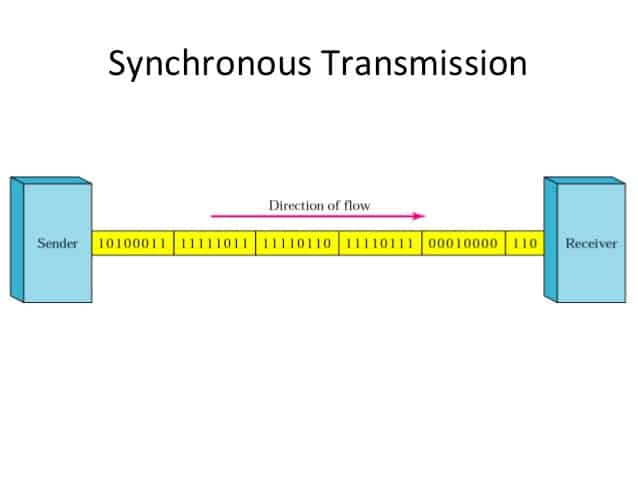Definition of synchronous transmission in Network Encyclopedia.
What is synchronous transmission?
Synchronous transmission is a mode of serial transmission for digital modems, ISDN terminal adapters, Channel Service Unit/Data Service Units (CSU/DSUs), and other telecommunications devices. The main characteristic is a continuous stream of data in the form of signals which are accompanied by regular timing signals which are generated by some external clocking mechanism meant to ensure that both the sender and receiver are synchronized with each other.

How It Works
Synchronous transmission uses clocking circuitry at both the transmitting station and the receiving station to ensure that communication is synchronized. This is in contrast to asynchronous transmission, in which start and stop bits are added to the beginning and end of each frame.
Devices that communicate with each other synchronously use either separate clocking channels to ensure synchronization between them or some kind of special signal code embedded in the signal for self-clocking purposes. Separate clocking lines are generally used when the distance between the data terminal equipment (DTE) and data communications equipment (DCE) is fairly short. Typically, the receiving station (such as a modem, a common form of DCE) provides the clocking signal to the transmitting station (usually a computer or a terminal).
The alternative is to use signal preamble, a special group of bytes (usually 8 bytes) called a SYNC signal that alerts the receiver that data is coming, synchronizes the clocks at the two devices, and starts the transmission. Special predefined voltage transition patterns familiar to both the transmitting and receiving stations are contained within the signal and are used to maintain synchronization between the devices. The receiver must extract this embedded information from the signal and use it to maintain synchronization between it and the transmitting station.
The following is a list of characteristics specific to synchronous communication:
- There are no gaps between characters being transmitted.
- Timing is supplied by modems or other devices at each end of the connection.
- Special syn characters precede the data being transmitted.
- The syn characters are used between blocks of data for timing purposes.
Difference between Synchronous and Asynchronous Transmission
One of the major differences is that in Synchronous Transmission, the sender and receiver should have synchronized clocks before data transmission. Whereas Asynchronous Transmission does not require a clock, but it adds a parity bit to the data before transmission.
Furthermore, the synchronous transmission uses synchronization characters while asynchronous method employs start/stop bits, in order to alert the modem when data are being sent and when are these transmissions are completed are known as message characters.
Synchronous transmission interfaces are generally about 20 percent faster and somewhat more reliable than comparable asynchronous interfaces.
Both Synchronous and Asynchronous Transmission have their advantages and disadvantages. Asynchronous is simple, economical and used for transmitting a small amount of data. Conversely, Synchronous Transmission is used for transferring the bulk of data as it is efficient and has less overhead. Hence, we conclude that both Synchronous and Asynchronous Transmission are necessary for data transmission.